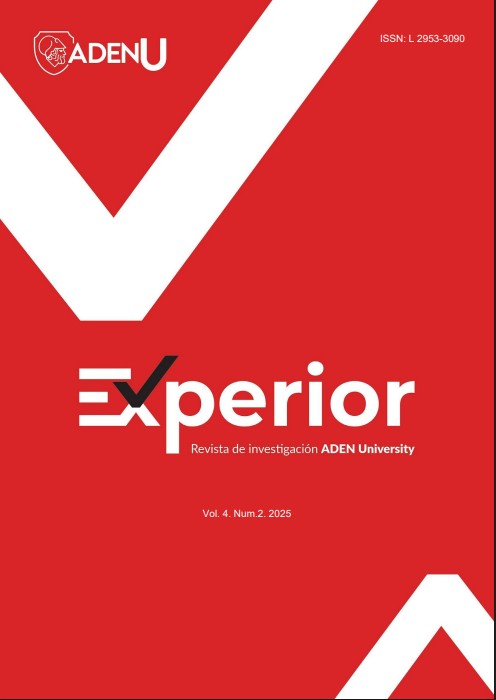Sensory inclusion in marketing campaigns for people with disabilities through inclusive neuromarketing
DOI:
https://doi.org/10.56880/experior42.5Keywords:
sensory marketing, universal design, sensory disability, inclusive neuromarketing, functional diversityAbstract
Marketing campaigns face barriers to connecting emotionally and sensorially with diverse audiences, particularly individuals with sensory or cognitive disabilities, which limits their access as consumers. This study aimed to analyze how inclusive sensory elements are integrated into advertising campaigns, proposing a more empathetic and accessible marketing perspective. A qualitative, interpretative documentary methodology was applied, using thematic content analysis on 72 specialized documents, from which 29 were selected as core literature and 14 as complementary sources. The topics addressed included sensory marketing, accessibility, neuromarketing, universal design, and functional diversity. The results reveal progress toward more inclusive strategies, although sensory integration remains partial and fragmented. Initiatives such as IKEA’s ThisAbles and the accessible campaigns by Coca-Cola and Pepsi demonstrate innovations in adapting visual, tactile, and auditory stimuli, yet these remain isolated efforts rather than consolidated policies. The discussion underscores the need to systematize sensory inclusion through universal design and specialized professional training, leveraging the potential of neuromarketing to better understand how people with disabilities process stimuli. The study concludes that sensory inclusion benefits these audiences, enhancing overall communication effectiveness.
Downloads
References
Barrientos-Báez, A., Baraybar, A., & Pocevičienė, R. (2024). Retos del neuromarketing en el ámbito académico y empresarial. Revista de Ciencias de la Comunicación e Información, 29, 1-5. https://dialnet.unirioja.es/descarga/articulo/9735881.pdf
Benneth Iloka, C. & Onyeke, K. J. (2020). Neuromarketing: a historical review. Neuroscience Research Notes, 3(3), 27-35. https://doi.org/10.31117/neuroscirn.v3i3.54
Bitbrain. (2018). Laboratorios y técnicas de neuromarketing habituales: EEG, eye-tracking, GSR, IRT, etc. https://n9.cl/83sd
Casale, R. (2024). Can you hear me? The inclusive advertising and its representation. puntOorg International Journal, 9(2), 208-227. https://goo.su/qmRqK
Chatterjee, H. J., Hannan, L., & Thomson, L. (2016). An introduction to object-based learning and multisensory engagement. In Engaging the senses: Object-based learning in higher education (pp. 1-18). Routledge.
Connell, B. R., Jones, M., Mace, R., Mueller, J. Mullick, A., Ostroff, E., Sanford, J., Steinfeld, E., Story, M. & Vanderheiden, G. (1997). The principles of universal design. https://n9.cl/13m99
EOM. (2022). Designing for Accessibility: How Inclusive Billboards Create Broader Brand Reach. https://n9.cl/zk5m3
Finocchiaro, F. (2024). Marketing y discapacidad sensorial: accesibilidad en productos y publicidades. Revista de marketing y publicidad, (10), 73-96. https://doi.org/10.51302/marketing.2024.21363
Ftah Ftah, K. (2021). Estrategia de marketing de contenidos inclusiva: accesibilidad de las campañas de marketing para personas con discapacidades sensoriales. (Tesis)
Goiri, L. L., & Rodríguez, C. R. (2023). Mejora de la experiencia de usuario mediante la inclusividad: pautas para generar contenidos web más accesibles para personas con discapacidades sensoriales. Questiones Publicitarias, 6(31), 09-18. https://doi.org/10.5565/rev/qp.376
Grandin, T. (2015). Pensar con imágenes: mi vida con el autismo. Alba Editorial.
Hultén, B. (2017). Branding by the five senses: A sensory branding framework. Journal of brand strategy, 6(3), 281-292.
Kotler, P., & Keller, K. L. (2006). Dirección de marketing. Pearson Educación.
Krishna, A. (2011). An integrative review of sensory marketing: Engaging the senses to affect perception, judgment and behavior. Journal of consumer psychology, 22(3), 332-351. https://doi.org/10.1016/j.jcps.2011.08.003
Krishna, A. (2012). An integrative review of sensory marketing: Engaging the senses to affect perception, judgment and behavior. Journal of consumer psychology, 22(3), 332-351. https://doi.org/10.1016/j.jcps.2011.08.003
Krishna, A., & Schwarz, N. (2014). Sensory marketing, embodiment, and grounded cognition: A review and introduction. Journal of consumer psychology, 24(2), 159-168. https://doi.org/10.1016/j.jcps.2013.12.006
Labers Team. (2022). Explorando los sentidos: el impacto del branding sensorial en la percepción del consumidor. https://n9.cl/nech8
Landaeta-Bejarano, Z. N., Olaya-Reyes, J., Lara-Pilco, G., & Aguilar-Castro, N. (2024). Percepción de las personas con discapacidad visual sobre la experiencia sensorial agroturística en Granja integral. Revista Internacional de Gestión, Innovación y Sostenibilidad Turística-RIGISTUR, 4(1), 44-56. https://doi.org/10.51260/rigistur.v4i1.479
Lindstrom, M. (2008). Buyology: Truth and lies about why we buy. Crown Currency. https://delfi.rs/_img/artikli/2013/11/kupologija.pdf
López-Ortega, M. G. (2023). Diseño a partir de la tecnología para la mejora de la calidad de vida: Diseño paramétrico de un producto de apoyo para niños con movilidad reducida. [Tesis de Maestría]. Universidad Complutense.
Lupton, E., & Lipps, A. (Eds.). (2018). The senses: Design beyond vision. Chronicle Books.
Mace, R. (1985). Universal Design: Housing for the Lifespan of All People. Center for Universal Design at NC State. https://n9.cl/89nyp
Martín, G. (2012). Comunicación inclusiva: una experiencia en creación de campañas sobre discapacidad intelectual. Area Abierta, (31), 1. https://doi.org/10.5209/rev_ARAB.2012.v31.38967
Mejía Bohórquez, E., Jaramillo López, J. F., Restrepo Aristizábal, S., Gutiérrez Posada, V., & Maya Cadavid, L. M. (2014). Diseño inclusivo: Comunicación para personas con discapacidad visual aplicada al punto de venta. Publicuidad. 3(1), 102-141. https://goo.su/xyt0Sa
Microsoft. (2023). Elevando el nivel de accesibilidad. https://www.microsoft.com/en-us/accessibility
Morgan, H. (2019). Connections Between Sensory Sensitivities in Autism; the Importance of Sensory Friendly Environments for Accessibility and Increased Quality of Life for the Neurodivergent Autistic Minority. PSU McNair Scholars Online Journal, 13(1), 11. https://doi.org/10.15760/mcnair.2019.13.1.11
Norman, D. (2013). The design of everyday things. Basic Book.
Obrist, M., Gatti, E., Maggioni, E., Vi, C. T., & Velasco, C. (2017). Multisensory experiences in HCI. IEEE MultiMedia, 24(2), 9-13. https://doi.org/10.1109/MMUL.2017.33
Piqueras, M. E. (2025). Neuromarketing sensorial: el impacto de los sentidos en el comportamiento del consumidor. Revista de Ciencias de la Comunicación e Información, 30, 1-22. https://doi.org/10.35742/rcci.2025.30.e315
Plassmann, H., Venkatraman, V., Huettel, S., & Yoon, C. (2015). Consumer neuroscience: applications, challenges, and possible solutions. Journal of marketing research, 52(4), 427-435. https://doi.org/10.1509/jmr.14.0048
Sánchez Calvo, M. I. (2025). La representación de las personas con discapacidad en las cadenas generalistas de televisión en España (1990-2023). (Tesis Doctoral). Universidad Complutense de Madrid.
Santillan Santa Cruz, R. (2022). Las personas con discapacidad como consumidores vulnerables en el comercio electrónico: el problema de la accesibilidad digital. Actualidad Jurídica Iberoamericana, 16, 1412-1431. https://goo.su/xNAR
Sheth, J., & Sisodia, R. (2012). The 4 A's of marketing: Creating value for customer, company and society. Routledge. https://doi.org/10.4324/9780203802168
Singer, J. (2017). Neurodiversity: The Birth of an Idea. Copyright © 2016 and 2017 Judy Singer. https://goo.su/AE18HKm
Spence, C. (2021). Sensehacking: How to use the power of your senses for happier, healthier living. Penguin UK.
Tautiva Gúzman, M., & González Báez, M. (2023). Plan de negocios para la creación de una empresa de marketing sensorial para mipymes de Bogotá bajo un enfoque de gestión de proyectos (Tesis de Maestría). Universidad EAN.
TBWA Neboko. (2024). This Billboard Smells Like McDonald's French Fries. https://lbbonline.com/news/this-billboard-smells-like-mcdonalds-french-fries
Team Lewis. (2023). Ikea ThisAbles: campaña de marketing social. En Marketing Spain. https://n9.cl/huxphy
Velasco, C., & Obrist, M. (2021). Multisensory experiences: A primer. Frontiers in Computer Science, 3, 614524. https://doi.org/10.3389/fcomp.2021.614524
Velasco, C., Obrist, M., Petit, O., & Spence, C. (2018). Multisensory technology for flavor augmentation: a mini review. Frontiers in Psychology, 9, 26. https://doi.org/10.3389/fpsyg.2018.00026
W3C. (2022). Making the Web Accessible. https://www.w3.org/WAI/
WebAIM. (2025). The WebAIM Million. The 2025 report on the accessibility of the top 1,000,000 home pages. https://webaim.org/projects/million/
Zhang, J., Zhu, T., & Hu, C. (2025). Application Model of Museum Cultural Heritage Educational Game Based on Embodied Cognition and Immerse Experience. ACM Journal on Computing and Cultural Heritage. https://doi.org/10.1145/3727343
Downloads
Published
Issue
Section
License

This work is licensed under a Creative Commons Attribution-NonCommercial 4.0 International License.










